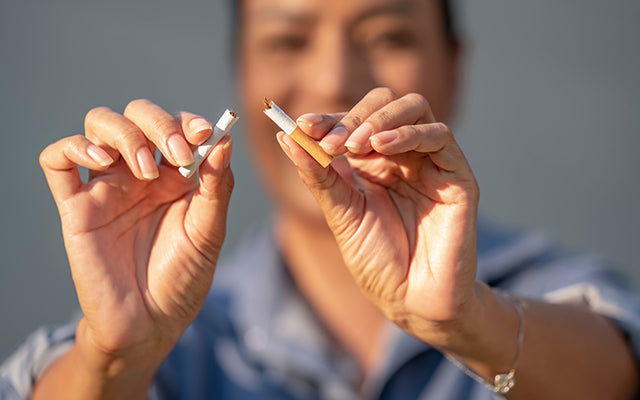Skin & Smoking

The effects of smoking on the skin, teeth, and hair can add years to one’s appearance. Additionally, it impacts fertility, heart, lung, and bone health. “smoker’s face” refers to the distinguishing traits of a smoker’s face, which typically make them appear older.
A “SMOKER’S FACE” MAY CONTAIN ONE OR MORE OF THE FOLLOWING ASPECTS:
Generally radiating at right angles from the upper and lower lips or eye corners, deep lines on the cheekbones, or multiple shallow lines on the cheeks and lower jaw.
A slenderness of the facial features that emphasises the underlying bone outlines. The skin alterations of early smokers consist of somewhat sucked-in cheeks. In certain instances, these alterations are accompanied by a leathery, worn, or coarse skin texture.
A thin skin that develops a faint grey pigmentation over time.
Quick links
- Skin clinic in Bangalore
- Skincare in Bangalore
- Hair care in Bangalore
- Skin specialist in Bangalore
- Hair specialist in Bangalore
- Skincare In Jayanagar
- Skincare Clinic in Banashankari
- Skincare Clinic in JP Nagar
- Acne Treatment
- Pigmentation Treatment
- Stretch Marks Treatment
- Tatoo and Mole Removal
- Skin Rejuvenation
SYMPTOMS OF SMOKER’S SKIN
augmentation of facial wrinkles
Overall, the skin is grey and leathery in texture.
Swelling of the face
Unnaturally aged appearance
Unevenly thickened skin
Fingers with a yellow hue.
Loss of skin moisture leading to dryness.
EFFECTS OF SMOKING ON THE SKIN
Exposure to tobacco smoke lowers capillary and arteriolar blood flow, perhaps causing damage to connective tissue that aids in the maintenance of healthy skin. Cigarette smoke also damages the cells that produce collagen and elastin, the skin’s structural proteins. Tobacco smoke is phototoxic, and its toxicity rises in the presence of the sun’s ultraviolet rays, inflicting twice as much damage to skin cells. Smoking can reduce the skin’s nutrition supply and increase the accumulation of hazardous waste products.
Tobacco smoke contains over 4,000 chemicals, many of which cause the breakdown of collagen and elastin, the fibres that give skin its strength and flexibility. Smoking or merely being in the presence of smokers destroys the skin’s structural components, resulting in drooping skin and deeper wrinkles. The nicotine in cigarettes induces constriction of the blood vessels, decreasing blood flow to the epidermis.
Smoking robs the skin of oxygen and nutrients, resulting in a pale complexion. Consequently, some smokers seem pale, while others suffer skin discoloration. On the face and hands, age spots or patches of darker skin tone are widespread. While excessive sun exposure may cause these spots in anybody, evidence indicates that smokers are more susceptible. Smoking can also induce telangiectasia, a skin disorder characterised by thin red lines caused by the dilatation of small blood vessels. While holding a cigarette between your fingers may appear trendy, with time your fingernails, surrounding skin, and teeth become discoloured by the tobacco. The good news is that after you quit smoking, these stains tend to vanish.
Low moisture content – Smoking decreases the skin’s hydration and Vitamin A, which is necessary for neutralising free radical damage. This ultimately leads to skin dryness.
Poor wound healing – Smoking reduces the skin’s capacity to renew and mend itself. One of the hazardous components of tobacco smoke, nicotine, causes blood vessels to constrict, therefore limiting the food supply essential for skin regeneration. Carbon Monoxide is another hazardous component of tobacco smoke that decreases oxygen passage through the body, resulting in a toxic waste buildup that prevents injured cells from repairing.
The region surrounding the mouth is affected by smoking, resulting in the formation of fine lines. First, smoking causes “the smoker’s pucker” because smokers exercise muscles around their lips that give them dynamic creases that nonsmokers do not have. Second, there is a reduction in flexibility. Both of these causes result in deep lines around the lips.
Eye wrinkles (crow’s feet) – Eventually, everyone develops wrinkles on the outside of their eyes, but smokers acquire these wrinkles earlier and more deeply. Heat from smoking and straining to keep smoke away from the eyes contribute to the appearance of crow’s feet. Meanwhile, inhaled tobacco compounds cause interior damage to the skin and blood vessels around the eyes.
Psoriasis – Psoriasis is a persistent skin ailment that often manifests as thick, scaly areas on the knees, elbows, scalp, hands, feet, and back. The spots may be white, red, or silver in colour. Recent research indicates that smokers are more likely to get psoriasis.
PREVENTION
Quit smoking – Quitting smoking is one of the most effective methods for repairing skin damage caused by smoking. Your skin absorbs more oxygen and nutrients as your blood circulation increases, allowing you to acquire a better complexion.
Maintain a skincare regimen — Once you quit smoking, your skin becomes more resistant to premature ageing and will benefit from a skincare regimen. By using lotions containing topical retinoid and antioxidants such as Vitamins C and E, it is possible to reverse the effects of smoking on the skin. In addition, sunscreen should be used daily.
Utilize oral antioxidants – These can aid in mitigating the negative effects of smoking.
Observe the tobacco-free impact – Abstaining from tobacco will lessen the stains on your fingers and toenails, and your teeth may become whiter.
TREATMENTS
Gel peels / chemical peels
CACI Therapy
Botox injections for smoker’s lines and crow’s feet
Oxygen Facial Treatment RF pixel


